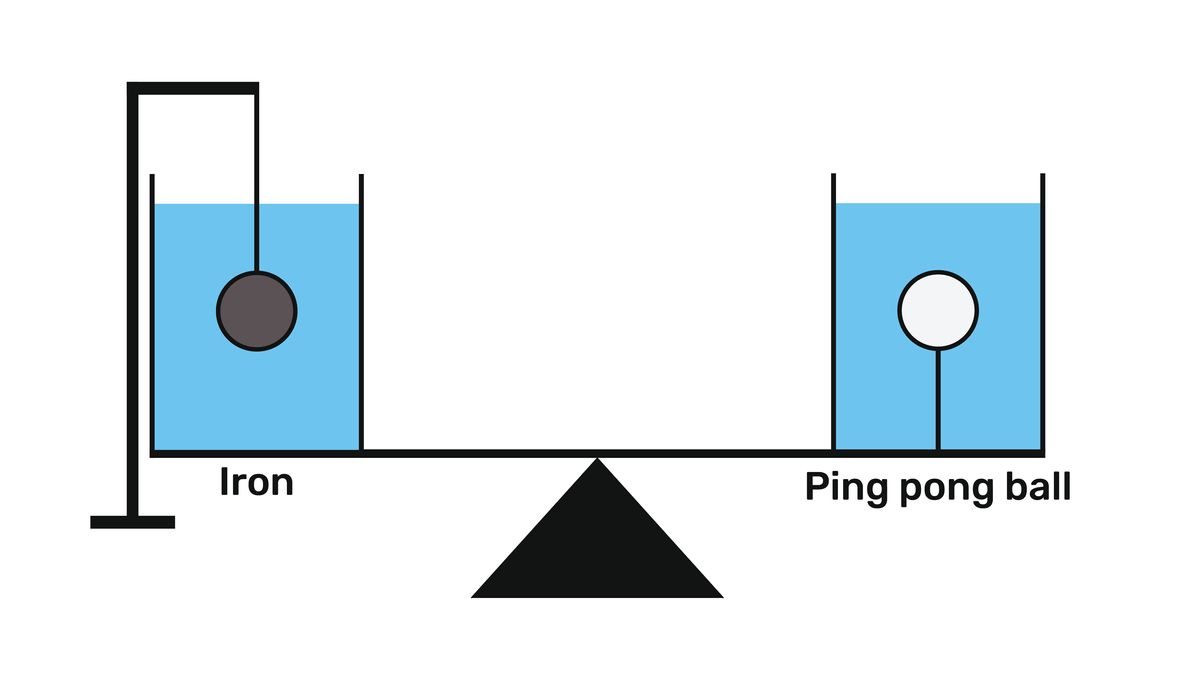
A buoyancy problem involving a ping pong ball, an iron ball, a few strings, some water, and a set of scales is causing a few arguments on Reddit where it was posted.
ADVERTISEMENT
“Where would the scale tip? On the left is a steel ball, on the right a ping-pong ball,” Reddit user Veiy wrote, posing the conundrum. “I think the scale would raise to the right since the [buoyancy] of the ping-pong ball pulls it upwards while the weight of the water is the same since both displace the same amount.”
So, which way does the scale tip? First, we need to know a little about buoyancy.
Buoyancy is an upward force in a fluid (any flowing substance, including air) exerted on all bodies within it. The force comes from the pressure within the fluid being greater the further down in the fluid you go. The pressure on the bottom of an object within the fluid is higher than at its top, causing the upward force. The Archimedes principle states that a body submerged or partially submerged in a fluid is acted on by the buoyant force in a magnitude equal to the weight of the fluid it displaces.
If the buoyant force of a fluid is greater than the downward force (its mass times the gravitational field strength) of an object placed within it, the object will float. But objects that are more dense than water (at the surface) will sink until the forces are equalized.
Now, let’s take a closer look at the setup. Both the iron and ping pong balls are the same size, meaning they displace the same amount of water, and are pushed upwards by the same amount of buoyant force, equal to the weight of the water which they have displaced.
“Now for the hanging ball the beaker does get heavier by this amount, because the buoyant force is now supporting some of the weight that used to be supported by this tension in the string. But it is now reduced and so beaker actually has more weight,” science communicator and physicist Derek Muller explains in a video on the topic for his YouTube channel Veritasium.
ADVERTISEMENT
“But for the ping pong ball, the downward force on the water is almost entirely counteracted by the upward force of the tension in that string on the bottom of the beaker. And, therefore, the weight of this beaker only increases by the weight of the ping pong ball itself, whereas for the hanging ball the weight increases by the weight of water it displaces.”
The result, as you can see for yourself, is that the beaker with the ping pong ball goes up, while the other beaker goes down. If the explanation of the string tension seems strange, take a look at what happens if you remove the string and instead push the ping pong ball down into the water the old-fashioned way, using your fingers.
ADVERTISEMENT
In this case, both balls experience the same amount of upward buoyant force as they are displacing the same amount of water. The equal and opposite downward forces on the water, without the string acting on the ping pong ball, means that both beakers get heavier by the same amount. The result is that the scales balance perfectly.
Source Link: Which Way Do The Scales Tip In This Simple Viral Experiment?